
Afifa Fiaz is currently a Junior in the Honors College at FIU. She is majoring in Biology and is currently a Medical Assistant at a surgical clinic. Her goal in life is to help people and give back to the community through medicine. She was born in Pakistan and loves to carry her culture in various ways. In her free time she likes to travel, cook, draw, and even host great events.
DOWNTOWN AS TEXT

“History Walk of Miami”
By Afifa Fiaz of FIU at Downtown Miami, 8 September 2021
Walking down the street of Miami and going through the historical events that took place there can change your whole perspectives of things. From learning about the Tequesta’s, who lived here from the beginning to how oranges played a part in the past.
Miami was originally founded by a rich women named Juliet Tuttle who grew oranges on her lands and lived in the Miami area. The majority of the citrus in Florida was killed by a strong freeze in the 1890’s, but not in Miami. Henry Flagler was building his railroad to deliver citrus to the northern states at the same time, however the freeze had a significant influence on his business as well. Julia Tuttle saw this as an opportunity send him a few oranges along with an invitation to expand his railroad down to Miami. A smart women one would call it!
Lummus Park, known to be the oldest public park of Miami holds some of the oldest structures. The home of William Wagner was one that really caught my eye. Wagner married a women of color and one with kids, in that era that was seen as shock . Not only did Wagner lived in that house with his family, he also used it as a church and a place where him and the Seminoles had meals and peace making conversation together. Having a house that was so different, yet one that every person was welcomed in is a goal of mine to build in the future one day.
OVERTOWN AS TEXT
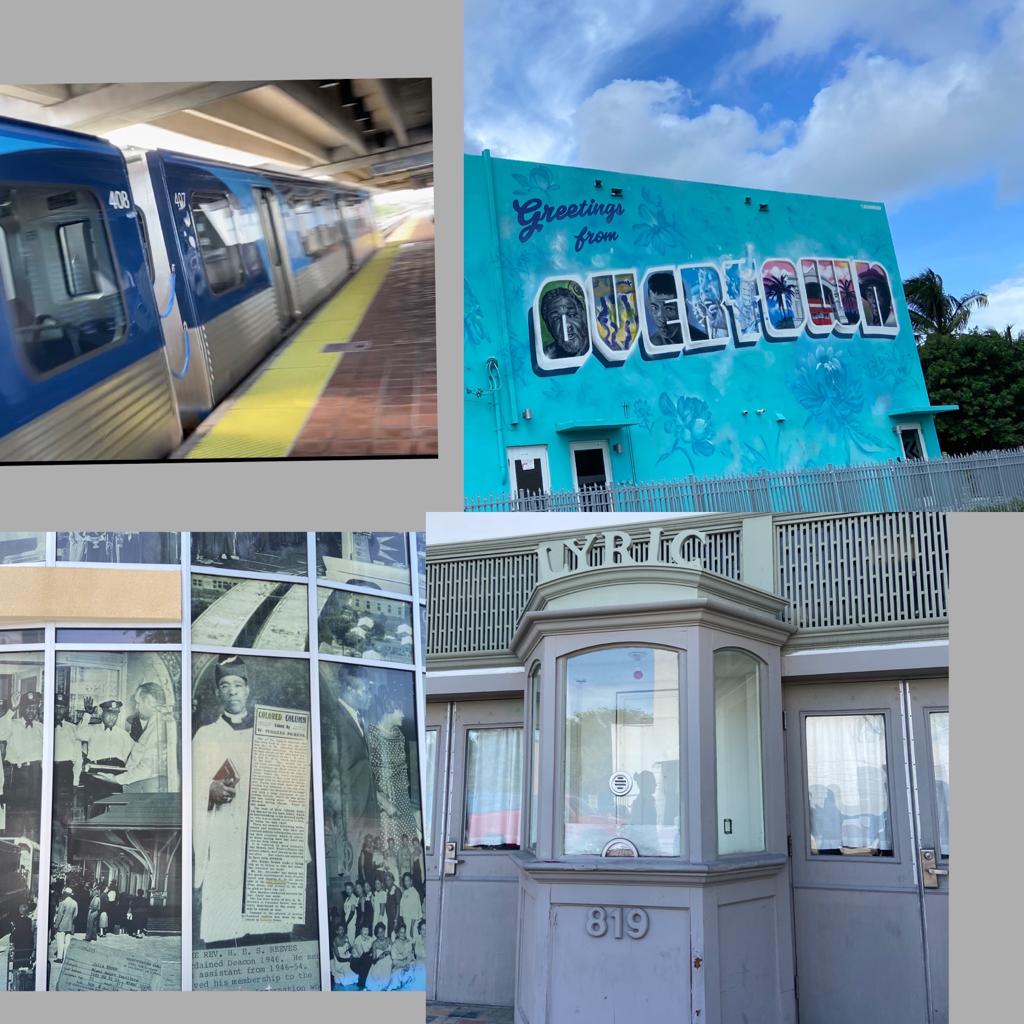
“Miami’s own New Orleans”
By Afifa of FIU at Overtown, September 22, 2021
Taking the Metrorail as a form of transportation taught me how to navigate around the city along with valuing my time. For someone who had a very negative perception of the Metrorail, it was quite surprising on my end to see how clean and efficient it was. In terms of energy usage, space occupancy, and number of passengers transported, the Metro Rail System has shown to be the most efficient. Some of the places we went to included Hialeah, Santa Clara, and my favorite Over town.
Many people living in Miami tend to forget about Over town, a Miami, Florida neighborhood located northwest of Downtown Miami. People’s stigmas and perceptions have caused them to be believe that taking I-95 while looking down at the town is better than driving through it. Over town also known as Colored Town during the Jim Crow era of the late nineteenth and early twentieth centuries was once the preeminent and is still the historic center for black business in Miami and South Florida. The town was once alive with musicians like James Brown, Josephine Baker, Aretha Franklin, Muhmmad Ali and many more! People would travel all across the country to come just hang out with the known and have small talks for only a dime! The town became silence when I-95 and 395 freeways built through the town. The freeways destroyed hundreds of homes and properties. Many at that time believed that this was an act of racism and segregation to keep the blacks from booming.
Vizcaya as Text

TOP: Biscayne Bay entrance of the house
BOTTOM: Back entrance of the house
“Originality Stolen?”
By Afifa Fiaz of FIU at Vizcaya on October 20, 2021
Vizcaya home and garden was once the home of rich James Deering. James Deering was millionaire who decided to build an estate in South Florida after being diagnosed with anemia. He loved sailing and boating, as well as landscaping and plant conservation. These hobbies played a significant role in the creation of Vizcaya. Deering began constructing on this 15-million-dollar home in 1912 officially initiating occupancy on Christmas Day 1916. The house’s architecture was influenced by Veneto and Tuscan Italian Renaissance with Baroque elements. Paul Chalfin, Burrall Hoffman, and Diego Suarez help build Vizcaya’s design, architecture, and landscape.

Vizcaya is displayed with artwork, furniture, and architecture from all over Europe and Asia. Deering imported pieces of all the places he visited to make Miami his home without keeping cultural appropriation in mind. For example, the statue of Bacchus, the god of wine and pleasure, had a leaf over the genitalia since it’s considered profane in American culture. This is considered very offensive in Rome culture as they do not have discomfort with human sexuality and bodies. Another fascinating thing in the house was Deering’s office which portrayed him as a very intellectual and busy man. However, when you take a closer look, the “books” in his office were nothing but a wall of illusion.
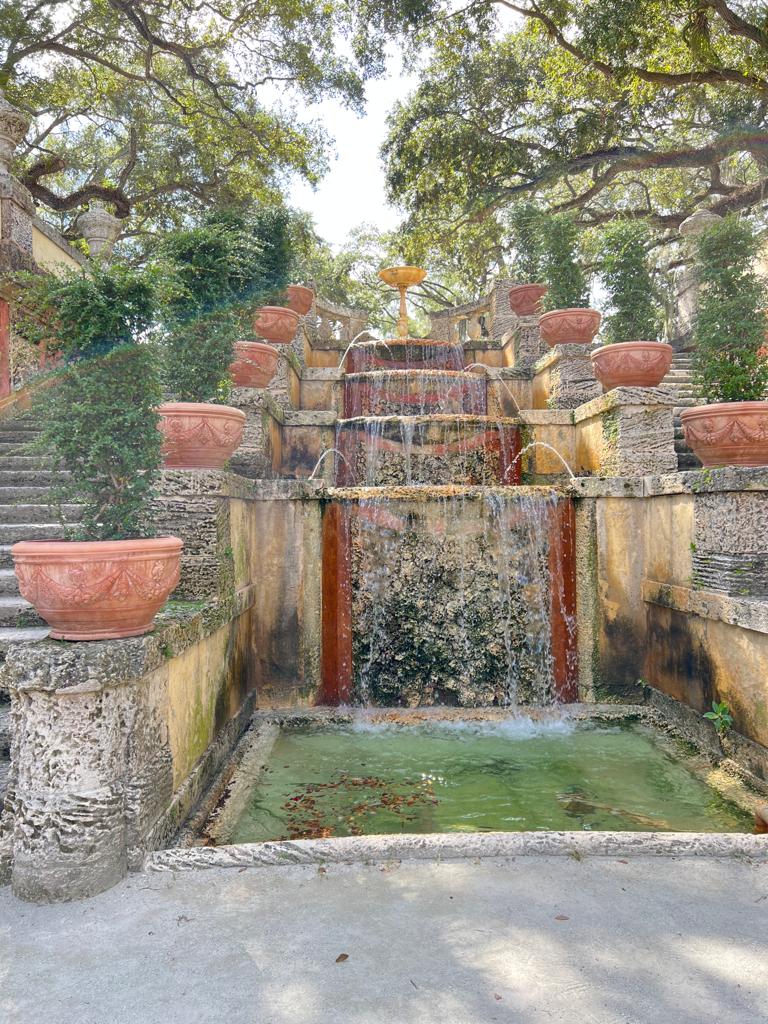
All in all, even with Vizcaya’s cultural appropriation and Deering’s ignorance to showing off his wealth in silly ways, Vizcaya has some of the most beautiful gardens. The Italian Renaissance gardens include some of the most breathe taking views and lovers’ spot. Gardens like these are what I aspire to include in my future homes one day
South Beach as Text

“Dive into Miami Beach’s History”
By Afifa Fiaz of FIU at South Beach on November 3rd, 2021
Miami Beach, a very well-known city worldwide, has some of the most unique views and architecture. South Beach is a neighborhood in Miami that has preserved most of the city’s historic architecture from when it was first developing. The pastel colors and the boat shaped structural designs take you back to the retro era.

Miami beach is often associated with tourism and fun times. There is even an Orb in the middle of two buildings known as the Betsy Orb. The Betsy Orb is a giant ball representing a beach ball stuck between two buildings. Today, Miami Beach is a site where people can have a good time, but its past tells a different narrative. Henry Flagler used Black African American slave labor to build Miami from ground up long after the civil war. Using Bahamians to build on their own land and still having it improperly done is very ironic.
Miami Beach’s classic design used several optical illusions to make the city appear upscale despite the fact that it was a low-budget urban culture. Land in Miami Beach was cheap at the time it was bought, and the structures built on it were vertical to give them a higher look.

Even with all its dark history, South beach gave the Jewish community a lot of hope. The community held events, built synagogues, and even had kosher places to eat. Today, the city of Miami Beach is focusing on the preservation of its original beauty as well as innovative approaches to improve traffic flow, as it is a place where walking short distance is faster than driving.
Everglades as Text
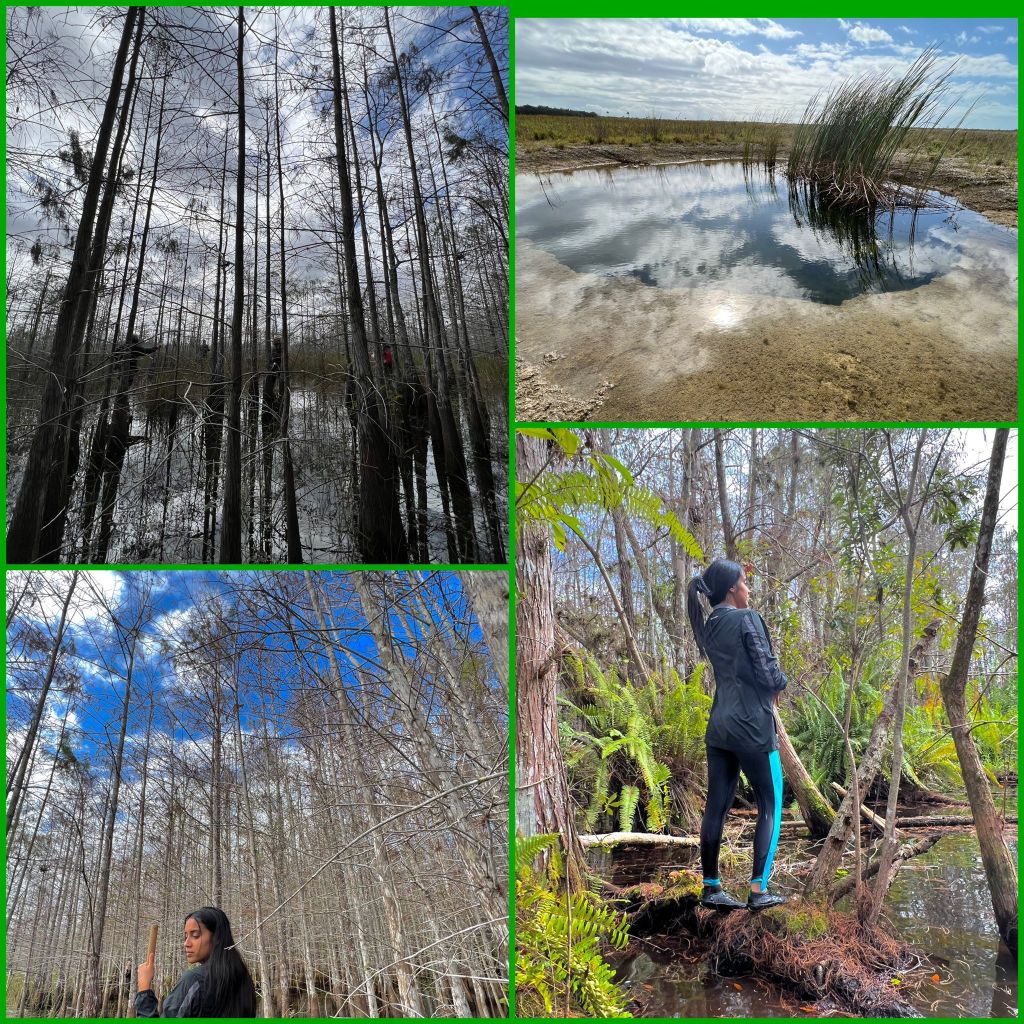
Bottom left: Taken by Carolina Echeverri //CC by 4.0
Bottom right: Taken by Oscar Roa //CC by 4.0
“Nature’s Beauty“
By Afifa Fiaz of FIU at Everglades National Park on January 12th, 2022.
On January 12th, I had the opportunity to slough slog through the Everglades. Slough slogging through the Everglades is a pristine method of derailing yourself from the tracks of your everyday life to become one with nature. My favorite part of the day was when we went to the Cypress Dome and stood in silence to hear and feel nature rather than just seeing it. Connecting with my senses helped me really make the most out of this experience. Being a student that also works full time, the fast life makes us forget the value of nature.
Not only was I able to appreciate the beauty of the Everglades, but I was also able to increase my knowledge of the vital resources provided by the Everglades. The Everglade provides fresh drinking water for about one-third of Floridians, protects our communities from severe weather conditions like hurricanes, and “Supports Florida’s $1.2 billion fishing industry.” The National Wildlife Federation. The Everglade is also home to about 789 different species, of which 39 are considered to be endangered Animals of the Everglades.
One of the things I found to be astonishing was the importance of each species and their unique traits to survive in the Everglades environment. For instance, the periphyton filters the freshwater and provides shelter for small insects or the Cypress Tree with its strong trunks to withhold its structure even with the water constantly hitting it. We were also able to view a few Wood Storks up close and witness them hunt for food. Ranger Patty, our Everglade tour guide, mentioned that in mythology Wood Stork is a sign of good luck and harbinger of spring. It was surreal to be surrounded by such stunning scenery in such a natural state. All in all, the trip to the Everglades was the perfect way to start this year. We were practically a part of the landscape, with ultimate exposure.
Coral Gables as Text

“The City Inspired by Spain”
By Afifa Fiaz of FIU on January 26th, 2022
I had the opportunity of touring Coral Gables, a city located in Miami, with my class this week. City of Coral Gables was founded by George E. Merrick who bought 3000 acres of land in 1899 and established it as city in 1925 using the Mediterranean Revival style. Merrick’s Mediterranean Revival style was inspired by Washington Irving’s romance texts about Spain and Vizcaya of James Deering. It was built on oolite Limestone by Bahamians during the Depression period. Even with such intense segregation, Black Bahamians were the only ones who knew how to work Oolite limestone as it was a very difficult and only material available at that time.
Our tour started at the Coral Gables Museum that was once a police and fire station. It was designed by Phineas Paist and Harold Steward in 1939, to help provide the city safety and job opportunities. The structure of the museum was articulated around the mass of Depression architecture along with Mediterranean style. The museum is surrounded by numerous sculptures designed by female artists such as John Keller. The structures that stood out to me the most were the four pelicans that were seen above the entrance and even throughout the city. The pelicans symbolize sacrifice based on the popular myth around them that indicates “that pelicans bled them themselves in order to feed their young.” Our professor even compared himself with the pelican helping us see his efforts and hard work he put into our class lectures.
The tour continued to Giralda Plaza, the Biltmore Hotel, the Colonnade Building, Miracle Mile, Coral Gables City Hall, and lastly Coral Gables Elementary School. All these structures went along with Merrick’s vision of Spanish and Moorish type architecture. “The gleaming white coral rock, the palm trees, tropical flowers and verdure seemed to me to provide a natural setting with which Spanish architecture alone would harmonize.” The uniform architecture can be seen throughout city. For example, the moss curtains, stucco finishing, clay tile roofing, decoration around doorways and windows, loggias and round arches and columns. It was quite pleasing to see the constant structures of these buildings and how each one of them helped shaped the city’s beauty. My main concern for Coral Gables are the newer buildings, that aren’t depicting the older structures, take over. These newer office building are ruining the beauty and unique style of this city and it’s aesthetic. This isn’t just seen in Coral Gables but also in other areas in Miami. People aren’t respecting the city’s history and are destroying the vision of those who created them.
Works Cited
Stepulveda, S., & Bailly, J. (2022, January 28). Coral Gables Walking Tour. Bailly Lectures. Retrieved January 31, 2022, from https://baillylectures.com/miami/coral-gables-walking-tour/
River of Grass as Text
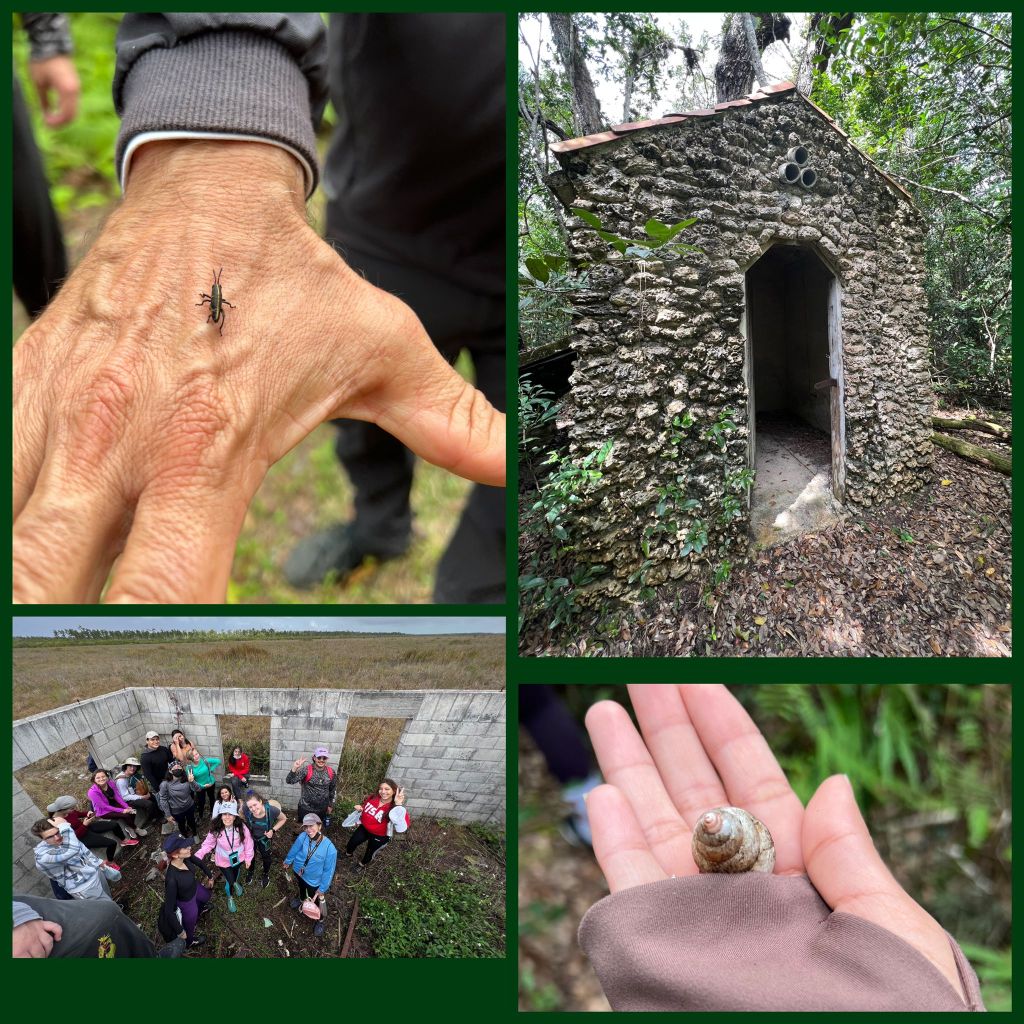
“Nature > Humans”
By Afifa Fiaz of FIU on February 16th, 2022 at the Everglades
No matter how many times one goes to explore the Everglades, there is always something new and unique to find every trip. The Everglades has a way of connecting us humans with nature in the most pristine way. It shows we can live side by side with nature without causing harm to it. Humans have a tendency to believe that they are superior to any other species and at times can cause more harm than good. The Everglades on the other hand shows how different organisms and species can coexist in the most beautiful way, such as the crocodiles and alligators.
Human impact on the Everglades has caused it to change a lot over the years. The water flow that was once controlled by plants and animals’ extraordinary characteristics were shifted by humans for agricultural development. When engineers rerouted the water flow in the late 19th century, it caused populations to scientifically decrease. The population of wade birds went down 90% The Everglades National Park! Even with plans to rehydrate the Everglades, it is impossible to gain what was lost due to the polluted phosphorus from fertilizer used on farms upstream. This further emphasizes the harmful and irreversible damage humans leave on this environment.
Another interesting thing seen in the Everglades are human efforts to build railway through it. Henry Flagler tried to expand his railroads by building through the Everglades. Despite his maximum efforts, he was unsuccessful as the Everglade was unsuitable for such construction. Additionally, more human efforts of building can be seen throughout the Everglades, such as remnants of farmhouses and feeding stations. Overtime, the Everglades began to consume these structures.
Despite human impact, the Everglades was able to maintain its long-standing reputation. As Marjorie Stoneman Douglas said, “The miracle of the light pours over the green and brown expanse of saw grass and of water, shining and slow-moving below, the grass and water that is the meaning and the central fact of the Everglades of Florida. It is a river of grass.” Unfortunately if humans continue to destroy the Everglades, we will be left without this national treasure.
Work Cited
“Nps.gov Homepage (U.S. National Park Service).” National Parks Service, U.S. Department of the Interior, https://www.nps.gov/index.htm.
Design District as Text
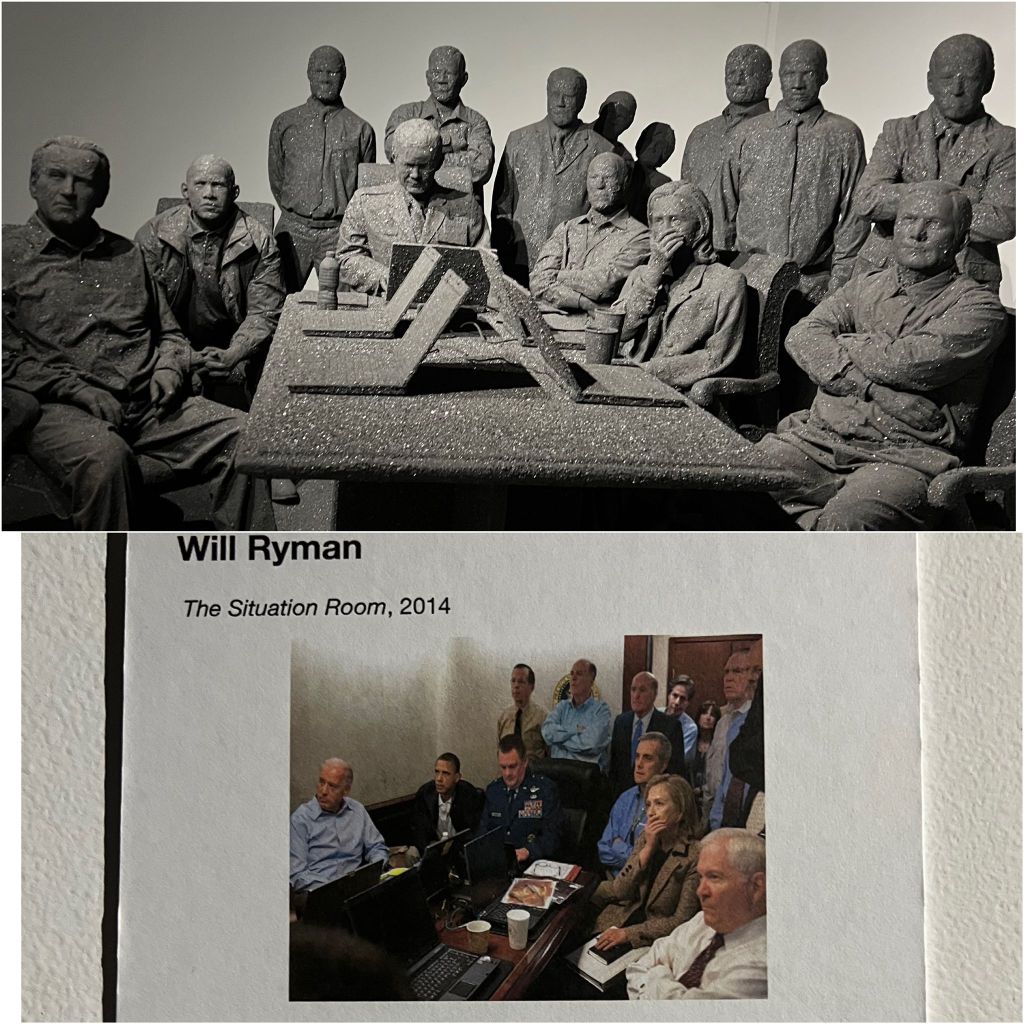
By Afifa Fiaz of FIU on February 23rd, 2022 at The Margulies Collection
Art in my opinion can be seen through two lenses: traditional and modern. In the past we have seen artist come up with pristine art pieces, ones which included traditions and customs of society. However, this has changed in the modern world. Artwork today portrays an artist own expressions and perspectives. Examples of modern art can be seen at the Margulies collection warehouse.
The Margulies collection, located in Miami, is a non-profit 50,000 square feet warehouse that’s dedicated to present exhibitions of contemporary art. It holds collections from Martin Z. Margulies, educational programs, special exhibitions and an international loan program. Lecture notes. One of the art pieces that really stood out to me at the Margulies Collection was the recreation of the situation room that recreate the situation the U.S. officials followed secret military operation to kill Osama bin Laden The Art Newspaper. This art piece created by Will Ryman is a perfect example of modern art world. You can see that the sculptures are built poorly and without any technique, the vision behind the piece was not political or monumental according to the artist rather it was supposed to help him feel that exact moment. This piece helps the audience see how warfare’s are handled in the world today.
Let’s take a look back at the Andrew Jacksons presidency and how he was able to stop civil war in 1832 because he was veteran and had seen the worst of wars. If we compare this to modern world era, I wonder if officials in charge that are fighting wars behind screens with a click of a button will be able to save the country from future wars without being in wars that didn’t take place behind screen. This piece shows how wars behind screens are causing humanity to be “turned off” when making decisions such as launching missiles that can destroy thousands of lives. It raises questions like: Can we really trust officials that have never been in war and have seen the horrifying effects it leaves on the world to make decisions that impact as all?
“So much destruction in modern war takes place miles and miles away from the source of the destruction, the human being who caused it.” James Dickey
Work cited
Stoilas, Helen. “Walk into the White House Situation Room with Will Ryman’s Dramatic Installation.” The Art Newspaper – International Art News and Events, The Art Newspaper – International Art News and Events, 3 Dec. 2021, https://www.theartnewspaper.com/2021/12/03/will-ryman-situation-room-margulies-collection-miami.
Bailly, John. “Miami Art Institutions.” Bailly Lectures, 11 Oct. 2021, https://baillylectures.com/miami/miami-art-institutions/.
Key Biscayne as Text

By Afifa Fiaz of FIU
This week our class was fortunate enough to learn the history of the Cape Florida Lighthouse. The Cape Florida Lighthouse is known as a time capsule based on its vast history. It was built in 1825 to help guide sailors around the Florida reef to avoid accidents. Cape Florida was also used for slave departure at one point since it was close to other free slave countries. On July 23, 1836, the Seminoles attacked the lighthouse as it was a refugee for white settlers after the Seminole War. Their frustration caused them to set the doors and windows on fire near the base of the light house destroying the stairs that lead to the top. This caused the keeper at that time, Joe Thompson, and his slave, Arron Carter, to get trapped. Thompson fired at the Indians and threw gun powder in the rising flames causing an explosion. The explosion made the Indians to believe that both men died, so they fleet on the boat. However, Thompson was still alive and was rescued by a passing ship and Carter was buried as he died in the incident. In 1846, the structure was rebuilt but it wasn’t until the 1970’s that was relit. (The Attack on the Cape Florida Lighthouse, 2019)
Today, the lighthouse is known as the oldest structure in South Florida and people are still able to visit it. What’s infuriating about this structure is the story displayed with it. The story is told through only side and is in complete ignorance of the Seminoles who were fighting to stay in their own land. The poor drawings of this event show the Seminoles as animals and cold-blooded humans that burnt down the lighthouse and showed Americans as these heroes who fought against them.
Learning about the history of the Cape Florida light house, I started to question our education system. As kids, we were taught history through one lens, the American lens. It focused on all the American victories and accomplishments instead of the unpleasant after effects of those events on other cultures. K-12 pupils are taught what the school boards have put in place. The same board that are putting in laws which restrict talking about racism or slavery as if such things didn’t exist. When kids are taught history, they aren’t thinking about the other side, it isn’t until they go to a higher education system such as college or university that they are taught to see other perspectives on past events. Unfortunately, not everyone gets the opportunity to gain an understanding of our past events through all lenses and go on about their lives knowing the unfinished history taught in schools.
Works cited
Hersh, Carl, and Kathy Hersh. “The Attack on the Cape Florida Lighthouse.” Dunn History, https://dunnhistory.com/the-attack-on-the-cape-florida-lighthouse-part-one/.
Coconut Groove as Text

By Afifa Fiaz of FIU on March 30th, 2022 in Coconut Groove.
Usually when one thinks of Coconut Groove, they imagine the lavish houses and life style; however, this city holds rich history of Miami. Coconut Groove is known to be the oldest permanent residence in Miami-Dade. The neighborhood that was once inhabited by Tequesta and Seminoles was later filled by black Bahamians in the 1880’s after the passing of the Homestead Act. The Bahamians settlers built houses, schools, churches, and a grave yard around the area known as “The Barnacle” today. Coconut Groove officially became a town in the early 1900’s after the America’s first Naval Air Station opened at Dinner Key, which put Coconut Grove on the map.
Coconut Groove also holds a structure known as the Coconut Groove Playhouse. The Grove, envisioned by Miami industrialists Irving Thomas, Fin Pierce, and designed by an architect by the name of Richard Kiehnel in Spanish Rocco style. In 1926, Thomas decided to sell the structure to Paramount Enterprises, Inc. to help bring in large crowds. The structure also served many other functions, such as stores on the ground story, offices on the second, and residences on the third. Unfortunately, the play house success comes to an end after the Great Depression. The structure even became a training school for the U.S. Army Air Corps navigators in World War 2. It isn’t until 1955, that the playhouse was purchased by George Eagle to be turned into a performance art center. The ownership of the theatre changed several times afterwards, eventually causing the State of Florida to buy it in 1980. This structure is still standing today and can be visited in Coconut Groove. Bailly’s lectures